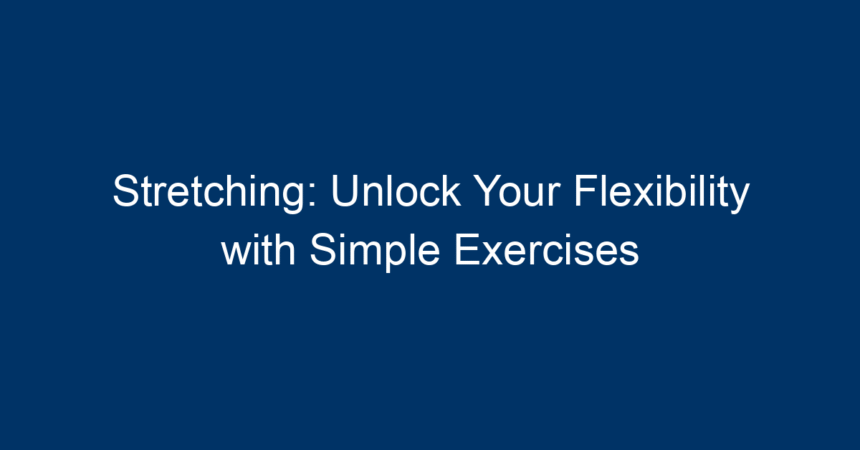Flexibility plays a crucial role in our overall health and well-being. While many people focus on strength training and cardio, stretching is often overlooked. However, incorporating a consistent stretching routine can enhance your flexibility, improve posture, and prevent injuries. In this article, we’ll delve into the benefits of stretching, explore some simple exercises, and provide tips on how to make stretching a regular part of your routine.
The Importance of Stretching
Stretching is more than just a pre-workout ritual. It serves several essential purposes for both physical and mental health:
1. Enhances Flexibility
Flexibility refers to the range of motion in your joints and muscles. Regular stretching can improve this range, making everyday activities easier and more comfortable. Whether you’re reaching for an item on a shelf or bending down to tie your shoes, increased flexibility can make these tasks effortless.
2. Prevents Injuries
One of the primary benefits of stretching is its role in injury prevention. Tight muscles are more prone to strains and tears. By maintaining flexibility through regular stretching, you can help reduce the risk of injuries, especially during physical activities.
3. Improves Posture
Poor posture is often a result of muscle imbalances, where some muscles become tight while others weaken. Stretching can alleviate tightness and promote balanced muscle development, ultimately leading to better posture.
4. Reduces Stress and Tension
Stretching has not only physical benefits but also mental health advantages. Engaging in stretching activities can help relieve tension built up in your muscles and promote relaxation. This can lead to reduced stress levels and a more tranquil state of mind.
5. Increases Blood Circulation
Regular stretching increases blood flow to your muscles and joints, promoting better circulation. This enhanced blood flow can help in recovery from workouts and decrease muscle soreness.
Different Types of Stretching
Understanding the different types of stretching can help you determine which techniques to incorporate into your routine. Here are some basic categories:
1. Static Stretching
Static stretching involves extending a muscle to its farthest point and holding that position for 15-60 seconds. This form of stretching is best suited for post-workout cool-downs as it helps lengthen muscles and improve flexibility.
2. Dynamic Stretching
Dynamic stretching is characterized by movement. It includes active movements that help warm up the muscles and improve overall flexibility. These stretches are typically done before workouts and can enhance performance in sports activities.
3. PNF Stretching
Proprioceptive Neuromuscular Facilitation (PNF) stretching involves both stretching and contracting the muscle group being targeted. Though often used in rehabilitation settings, it can be applied by anyone seeking to enhance their flexibility.
4. Ballistic Stretching
Ballistic stretching includes quick, bouncing movements that aim to push your muscles beyond their normal range of motion. This technique is less common but can benefit athletes who require extensive flexibility in their sport. However, it should be approached with caution to avoid injuries.
Simple Stretching Exercises for Beginners
Now that we’ve established the importance and types of stretching, let’s dive into some simple exercises designed to improve your flexibility. Remember to listen to your body; never stretch to the point of pain.
1. Neck Stretch
- How To: Sit or stand up tall. Slowly tilt your head toward one shoulder until you feel a gentle stretch. Hold for 15-30 seconds, then switch to the other side.
- Benefits: Reduces tension in the neck and shoulders.
2. Shoulder Stretch
- How To: Bring one arm across your body at shoulder height. Use the opposite hand to gently pull your arm closer to your chest. Hold for 15-30 seconds on each side.
- Benefits: Increases shoulder flexibility and relieves tightness.
3. Chest Stretch
- How To: Stand in a doorway with your arms bent at 90 degrees. Place your forearms on the door frame and lean forward gently. Hold for 15-30 seconds.
- Benefits: Opens up the chest and counteracts slouching.
4. Hamstring Stretch
- How To: Sit with your legs extended straight in front of you. Reach forward toward your toes while keeping your back straight. Hold for 15-30 seconds.
- Benefits: Improves flexibility in the hamstrings and lower back.
5. Quadriceps Stretch
- How To: Stand tall and grab your ankle behind you, pulling it toward your glutes. Keep your knees together. Hold for 15-30 seconds on each side.
- Benefits: Stretches the quadriceps, aiding in hip and knee mobility.
6. Hip Flexor Stretch
- How To: Step one foot forward into a lunge position, keeping the back straight. Lean into the front leg to deepen the stretch. Hold for 15-30 seconds and switch sides.
- Benefits: Alleviates tightness in the hip flexors, which is common in those who sit for long periods.
7. Calf Stretch
- How To: Stand facing a wall and place one foot behind the other. Keep your back leg straight and press your heel into the ground. Hold for 15-30 seconds, then switch legs.
- Benefits: Enhances calf flexibility, which is vital for walking and running.
Tips for Effective Stretching
To maximize the benefits of stretching, incorporate these tips into your routine:
1. Warm-Up First
Always perform a light warm-up before stretching. A few minutes of brisk walking or marching in place can prepare your muscles and prevent injury.
2. Breathe Deeply
Inhale deeply as you stretch. Focusing on your breath helps relax your body, making it easier to stretch further.
3. Avoid Bouncing
While it might be tempting to bounce during stretches, avoid ballistic movements. This can lead to muscle strains and injuries.
4. Stay Hydrated
Drink plenty of water before and after your stretching session. Hydration helps maintain muscle elasticity and flexibility.
5. Make it a Habit
To reap the full benefits of stretching, aim to incorporate it into your daily routine. Whether you dedicate time in the morning or evening, consistency is key.
Conclusion: Embrace the Power of Stretching
Incorporating stretching into your fitness routine can unlock your flexibility and contribute to your overall health. From improving posture to preventing injuries, the benefits are vast. Start with the simple exercises outlined above, and make stretching a regular part of your day.
Remember, flexibility is a journey, not a destination. Embrace the process, and you’ll find that the rewards are well worth the effort. Whether you’re an athlete or simply someone seeking better mobility, stretching is an essential practice that enriches both your body and mind. Start today, and unlock the many benefits of stretching!




